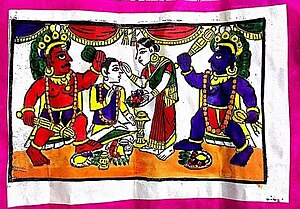| Bhai Dooj | |
|---|---|
| Also called | Bhai Tika, Bhau Beej, Bhai Phonta, Bhratri Dwitiya |
| Observed by | Hindus |
| Type | Religious |
| Date | Kartika 2 (amanta tradition) Kartika 17 (purnimanta tradition) |
| 2023 date | 15 November (i.e. Kartik 29) |
| Frequency | Annual |
Hindu festival dates The Hindu calendar is lunisolar but most festival dates are specified using the lunar portion of the calendar. A lunar day is uniquely identified by three calendar elements: māsa (lunar month), pakṣa (lunar fortnight) and tithi (lunar day). Furthermore, when specifying the masa, one of two traditions are applicable, viz. amānta / pūrṇimānta. If a festival falls in the waning phase of the moon, these two traditions identify the same lunar day as falling in two different (but successive) masa. A lunar year is shorter than a solar year by about eleven days. As a result, most Hindu festivals occur on different days in successive years on the Gregorian calendar. | |
Bhai Dooj, Bhai Tika, Bhaubeej, Bhai Beej, Bhai Phonta or Bhratri Dwitiya is a festival celebrated by Hindus on the second lunar day of the Shukla Paksha (bright fortnight) of Kartika, the eighth month of the Vikram Samvat Hindu calendar or the Shalivahana Shaka calendar. It is celebrated during the Diwali or Tihar festival and Holi festival. The celebrations of this day are similar to the festival of Raksha Bandhan.

In the southern part of India, the day is celebrated as Yama Dwitiya.[2] In the Kayastha community, two Bhai Doojs are celebrated. The more famous one comes on the second day after Diwali. But the lesser-known one is celebrated a day or two after Diwali. In Haryana and Uttar Pradesh a ritual also followed, a dry coconut (named gola in regional language) with klewa[clarification needed] tied along its width for worshipping is also used at the time of doing aarti of a brother.[3] In Bengal the day is celebrated as Bhai Phota, which comes one day after Kali Puja.
- ^ "Nepali Calendar 2078 Kartik | Hamro Nepali Patro". english.hamropatro.com. Retrieved 2021-07-27.
- ^ "Bhai Dooj 2020 date, time and significance". The Times of India. November 15, 2020. Retrieved 2020-11-15.
- ^ "भाई-बहन के परस्पर प्रेम और स्नेह का प्रतीक भाई दूज". Dainik Jagran (in Hindi). Retrieved 2020-11-15.